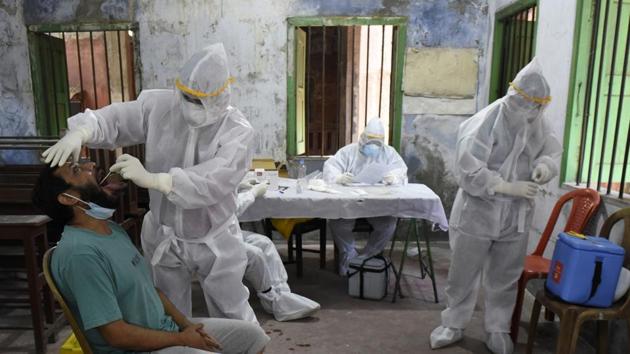Bengal’s Covid-19 confirmation rate decreases even as testing triples
Over the past fortnight, while Bengal’s average daily testing increased by over 227%, the average number of persons testing positive on day increased by only 33%.
Bengal’s Covid-19 positive confirmation rate – percentage of persons testing positive for every 100 samples tested – is recording a significant decrease despite a sharp rise in the number of tests, a trend that stands in contrast of those in its neighbouring states and some other major states.

Over the past fortnight, while Bengal’s average daily testing increased by over 227%, the average number of persons testing positive on day increased by only 33%. This has resulted in a sharp decline in the state’s positive confirmation rate, from 4.87% on May 5 to 3.11% on May 19, helping Bengal to improve its position.
As on May 20, India’s positive confirmation rate stood at 4.2%, with 105,750 people testing positive for 2,512,388 samples tested. This was slightly lower than 4.5% on April 22. In the first month of the lockdown, India’s testing had increased 24 times whereas the number of new positive cases grew by 16 times, chairman of India’s Covid-19 Empowered Group 2 had said on April 23.
In contrast, Bengal’s improvement is sharper. Between May 5 and 7, the state tested 7,637 samples, averaging 2,545 per day. In those three days, 289 people tested positive, with an average of 96 people daily. However, between May 17 and 19, the state tested 24,994 samples, with 8,331 tests daily on an average. During these three days, 385 people tested positive, with an average of 128 people per day.
This trend stands in contrast to those observed in neighbouring Bihar and Odisha, and the large states of Tamil Nadu, Karnataka, Rajasthan and Maharashtra, where positive confirmation rate increased with the number of average daily tests, even if slightly.
In Tamil Nadu, number of tests remained below 10,000 per day till May 4 and the state had a positive confirmation rate of 2.32% (4,058 positive of 174,232 samples tested). After testing another 173,055 samples between May 6 and May 19, with an average of 12,363 tests per day, the state’s positive confirmation rate stood at 3.58% (12,448 positives out of 347,287 samples tested).
In Bihar, as the number of tests increased, the positive confirmation rate rose from 1% on May 6 to 2.9% on May 19. In Odisha, the positive confirmation rate increased from .38% on May 5 to .97% on May 18.
The positive confirmation rate in Rajasthan remained almost the same – 2.31% on May 6 (3,177 people testing positive for 137,287 tests) to 2.33% on May 19 (5,845 people testing positive for 250,800 tests). The state’s increase in daily number of new cases has been in parity with the increase in the number of tests.
Between May 7 and 9, a total 18,717 tests were conducted, averaging 6,239 tests per day, with 531 persons testing positive, averaging 177 persons per day. Between May 17 and 19, a total 32,455 tests were conducted averaging 10,815 tests per day, and 885 people tested positive, with an average of 295 people daily.
Maharashtra’s ratio in increase in number of tests and the number of people testing positive rose almost in parity. It tested 28,428 samples during May 6-8, with an average of 9,476 samples daily, and altogether 3,538 people tested positive, averaging 1,779 people per day. During May 16-18, the state tested 32,457 samples averaging 10,819 tests per day, during which 5,958 people tested positive, or 1,986 people daily on an average.
In Karnataka, too, number of people testing positive increased with the number of tests. Between May 5 and 7, Karnataka tested 14,342 people, with a daily average of 4,780 tests and overall 54 people testing positive. Between May 16 and May 18, when it tested 17,939 samples with a daily average of 5,979 tests, the state recorded 190 new cases.
Bengal’s ruling party, Mamata Banerjee’s Trinamool Congress (TMC), claimed that this was because of the state’s success in containing the spread of the diseases. “The data reflects the state’s success in containing the diseases by enforcing a successful lockdown. People’s cooperation made every containment zone a success story,” said Santanu Sen, TMC Rajya Sabha MP and a doctor by qualification. Sen has been one of the important persons in chief minister Mamata Banerjee’s Covid-19 management team.
Public health experts Rezaul Karim and Punyabrata Goon, too, felt that Bengal may have managed to contain the spread to some extent.
Koushik Chaki, secretary of West Bengal Doctors’ Forum, however, was of the opinion that the figures may be a reflection of large number of tests conducted in relatively lesser affected areas. “Some pool testing has been conducted in north Bengal. A large number of tests have been conducted in the eight north Bengal districts and Murshidabad in south Bengal, where the virus’ spread has been nominal,” Chaki said.
A total of 74,711 tests were conducted in the state between May 5 and 19, of which 27,358 were conducted in the eight districts of north Bengal and Murshidabad. These nine districts have reported only 93 of the state’s 2,961 positive cases.






